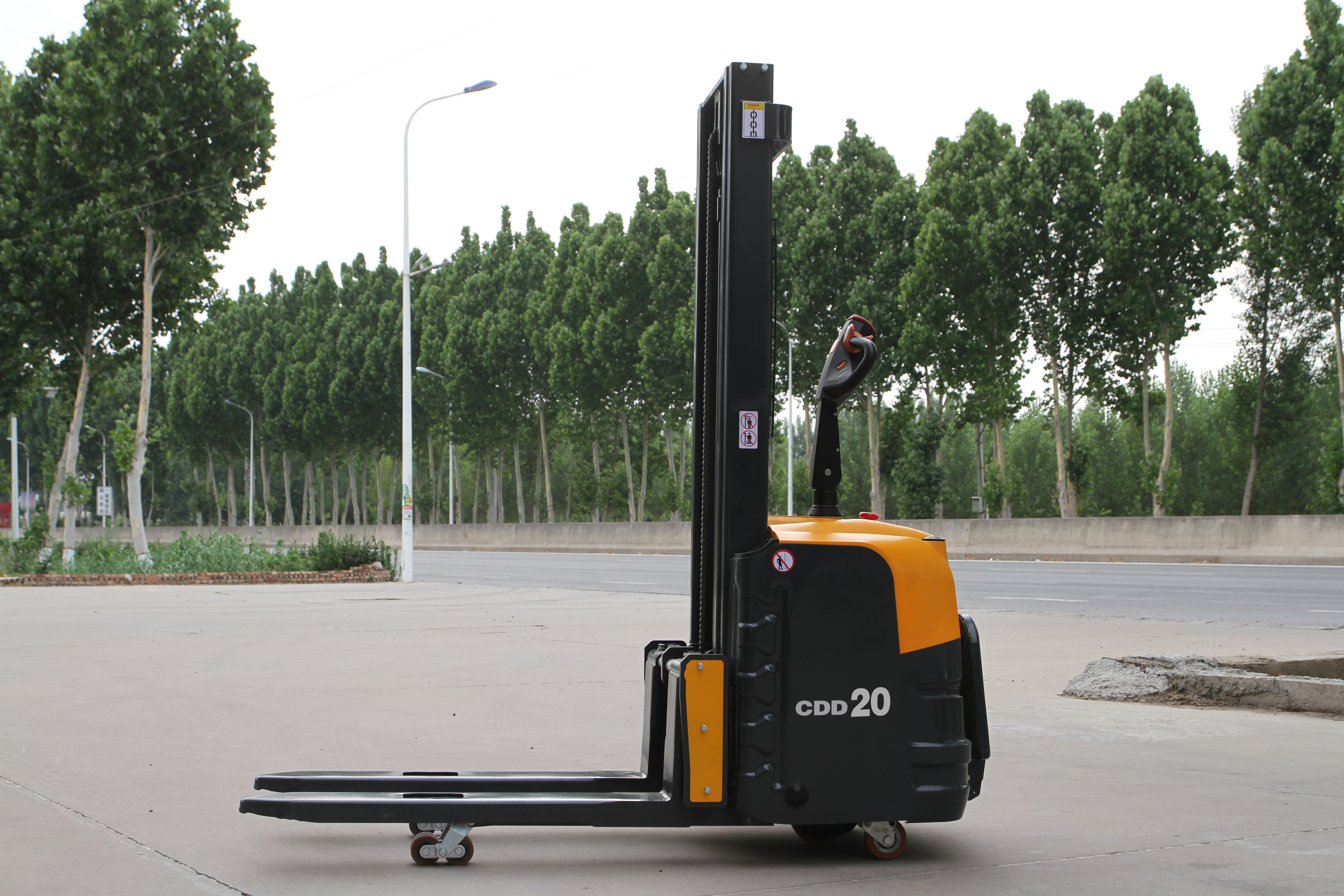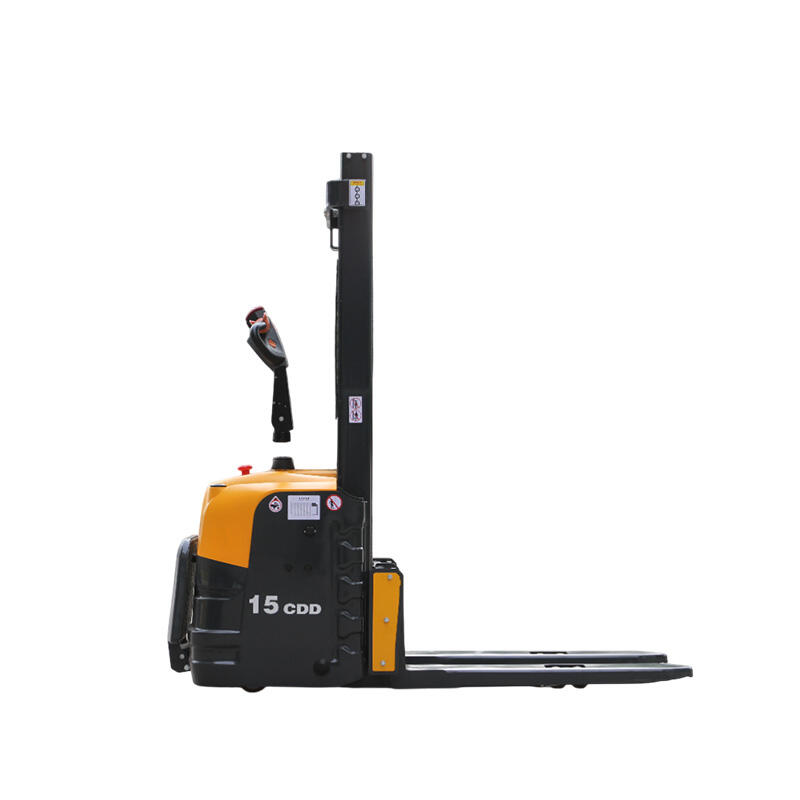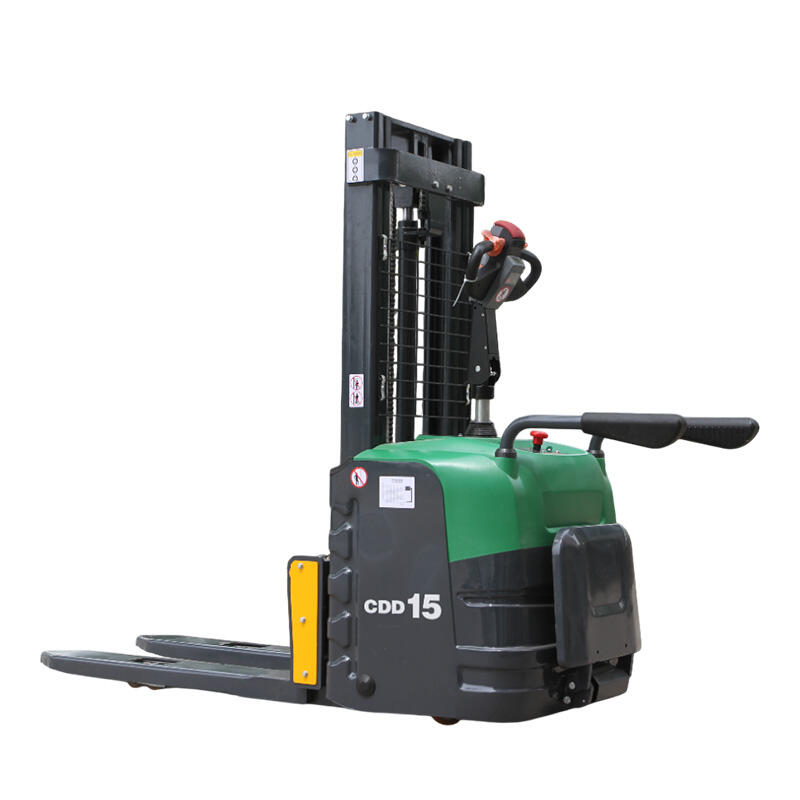An electric stacker is a versatile and efficient material handling device that uses electric power to lift, transport, and stack palletized goods, offering a significant upgrade over manual or semi-electric alternatives. It is widely used in warehouses, distribution centers, retail stores, and manufacturing facilities, providing a seamless blend of power, precision, and ease of operation. This equipment is designed to reduce manual labor, increase productivity, and enhance workplace safety, making it an essential tool for businesses looking to optimize their material handling processes. The core components of an electric stacker include a sturdy platform or forks, an electric lifting mechanism, a propulsion system, and a rechargeable battery. The forks, typically made of high-strength steel, are designed to slide under pallets and securely hold them during lifting and transport. They can be adjusted in width to accommodate different pallet sizes, from standard 1200x1000mm pallets to smaller or larger custom sizes, adding to the stacker’s versatility. The lifting mechanism, powered by an electric motor, uses either a hydraulic system or a direct-drive system to raise the forks to heights ranging from 2 meters to 6 meters, depending on the model. This electric-powered lifting eliminates the need for manual pumping, reducing operator fatigue and ensuring consistent performance throughout the workday. The propulsion system, also driven by the electric motor, allows the stacker to move forward and backward at adjustable speeds, typically between 2 km/h and 6 km/h. This enables operators to transport pallets across long distances with minimal effort, further boosting productivity. The battery, usually a lithium-ion or lead-acid battery, provides the power for both the lifting and propulsion systems. Lithium-ion batteries are increasingly popular due to their faster charging times, longer lifespan, and lighter weight compared to lead-acid batteries. They can be fully charged in 1-3 hours, allowing for quick top-ups during breaks, and they maintain consistent power output until they need recharging. Lead-acid batteries, while more affordable upfront, require longer charging times and regular maintenance, such as water refills, to ensure optimal performance. One of the key advantages of an electric stacker is its maneuverability, which is crucial for navigating tight spaces in warehouses and retail backrooms. Most models feature a compact design with a tight turning radius, allowing them to move through narrow aisles as narrow as 1.5 meters. This agility makes it possible to access pallets stored in tight corners or between closely spaced racks, maximizing storage space utilization. The stacker’s wheels are often made of polyurethane, which provides a smooth ride on concrete floors, minimizes noise, and prevents damage to indoor surfaces, making it suitable for use in noise-sensitive environments like hospitals and shopping malls. Safety is a top priority in the design of an electric stacker, with multiple features integrated to protect operators, goods, and equipment. Overload protection systems prevent the stacker from lifting loads that exceed its rated capacity, which typically ranges from 1000 kg to 3000 kg, reducing the risk of tip-overs and structural damage. Emergency stop buttons are prominently located on the control handle, allowing operators to immediately halt all operations in case of an emergency. Many models also include automatic braking, which engages when the operator releases the control handle, preventing unintended movement. The low center of gravity and stable base further enhance safety, even when lifting heavy loads to maximum heights. Operator comfort is another important feature of an electric stacker, with ergonomic design elements that reduce fatigue during long shifts. The control handle is often height-adjustable and equipped with a comfortable grip, making it easy to operate for operators of different sizes. The smooth acceleration and deceleration of the propulsion system minimize jolting, and the absence of manual pumping reduces physical strain on the operator’s arms and back. Some models include a fold-down platform for the operator to stand on during longer moves, eliminating the need to walk alongside the stacker and saving energy. The quiet operation of the electric motor, typically below 70 decibels, creates a more pleasant working environment and allows for better communication between operators. Electric stackers are highly versatile and can be customized to meet specific application needs. For example, some models are designed for use in cold storage environments, with features like cold-resistant batteries and components that can withstand temperatures as low as -30°C, making them suitable for frozen food warehouses and pharmaceutical storage facilities. Others come equipped with attachments such as side shifters, which allow the forks to move horizontally, making it easier to align pallets with racks or truck beds. Tilt functions are also available, enabling the forks to tilt slightly to prevent goods from sliding off during transport, which is particularly useful for handling unstable or irregularly shaped loads. Maintenance requirements for an electric stacker are relatively low compared to other material handling equipment, contributing to its cost-effectiveness. Regular maintenance tasks include checking the battery connections for corrosion, inspecting the forks for damage, and lubricating moving parts such as the lifting mechanism and wheel bearings. Lithium-ion batteries require no additional maintenance beyond regular charging, while lead-acid batteries need periodic checks to ensure proper electrolyte levels. Cleaning the stacker regularly to remove dirt and debris helps prevent rust and ensures that all components function smoothly. This low maintenance profile reduces downtime and operational costs, making the electric stacker a cost-effective choice for businesses. The applications of electric stackers are diverse, spanning various industries. In warehouses and distribution centers, they are used to move pallets between storage racks, loading docks, and sorting areas, streamlining inventory management and order fulfillment processes. In retail, they assist with restocking shelves from storage rooms, allowing staff to efficiently transport merchandise without disrupting customers. In manufacturing facilities, they transport raw materials to production lines and finished products to shipping areas, integrating seamlessly into production workflows. They are also used in logistics for loading and unloading trucks, reducing the time and effort required to transfer goods between vehicles and storage areas. In conclusion, an electric stacker is a valuable investment for businesses seeking to improve efficiency, safety, and productivity in their material handling operations. Its electric power system, maneuverability, and versatile design make it suitable for a wide range of applications, from small retail stores to large industrial warehouses. With ongoing advancements in battery technology and design, electric stackers continue to evolve, offering even better performance, longer runtimes, and lower operational costs. By choosing an electric stacker, businesses can reduce their environmental impact, enhance workplace safety, and increase their bottom line, making it an essential piece of equipment in modern material handling.


